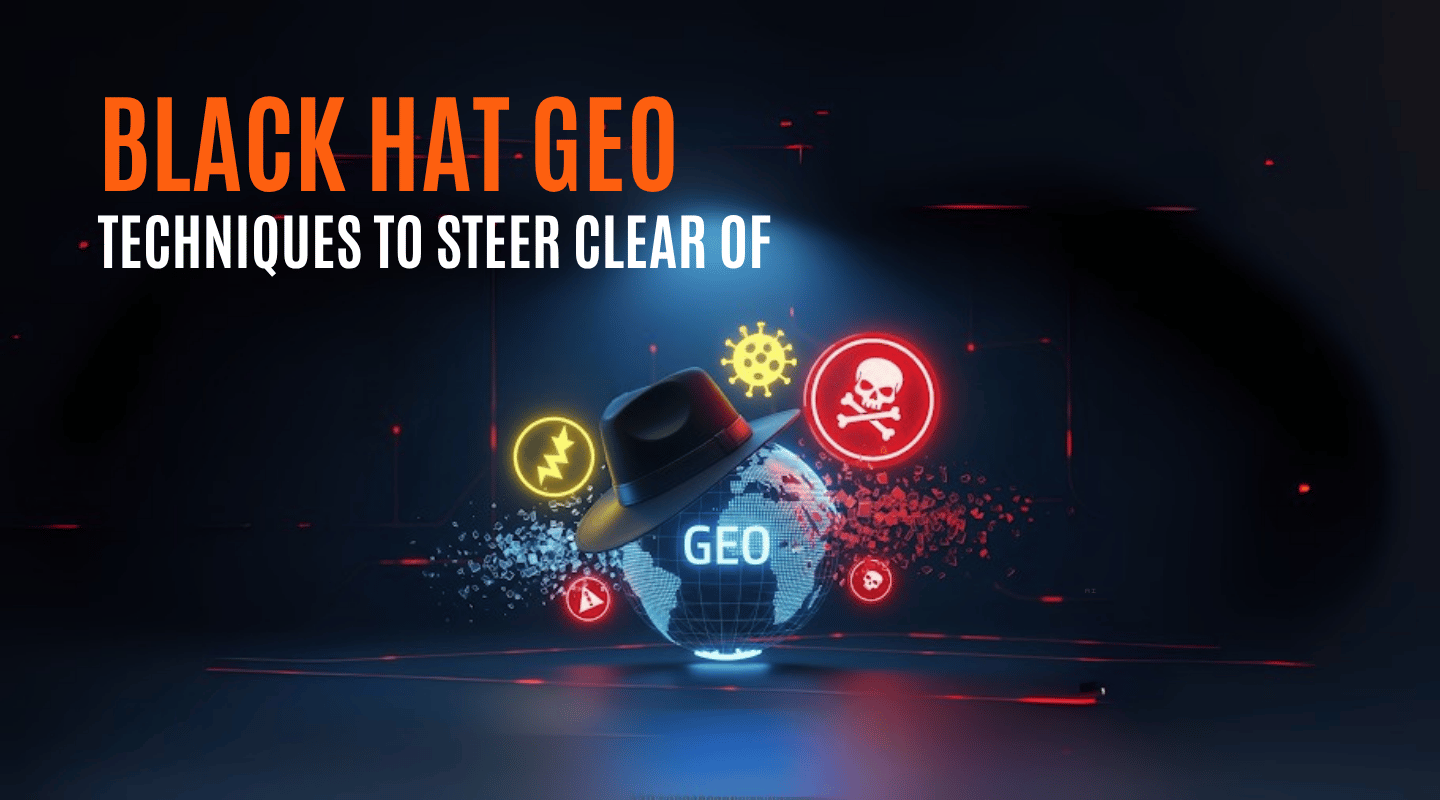Introduction
In the fast-paced digital landscape of 2025, brands are turning to GEO-targeting and AI-powered marketing to reach the right audience at the right time. While this combination is transforming how businesses connect with customers, the rise of black hat GEO techniques is equally alarming.
These shady practices promise quick wins but come with heavy risks—ranging from search engine penalties and brand reputation damage to legal consequences. If your business relies on GEO-driven strategies, knowing what not to do is just as important as knowing what works.
In this blog, we’ll uncover 7 black hat GEO techniques to avoid, answer frequently asked questions, and share insights to help you stay compliant, sustainable, and future-proof.
1. Cloaking GEO Content
One of the most common black hat GEO tactics is cloaking, where websites display different content to search engines than they do to users. For example, a site may show Google a clean landing page but redirect users in a specific location to spammy or irrelevant content.
Why to avoid it:
- Google’s algorithms are highly advanced in detecting cloaking.
- Penalties include de-indexing your website.
- User trust plummets once they discover misleading content.
2. Fake GEO-IP Redirects
Marketers sometimes manipulate IP addresses to fake GEO locations and trick search engines into believing their site is relevant to multiple regions.
The risk:
- Search engines flag this as deceptive.
- Potential loss of organic traffic.
- Damages long-term local SEO credibility.
Instead, use legitimate GEO-targeting tools that personalize experiences for genuine audiences.
3. Keyword Stuffing with GEO Modifiers
Some businesses overuse location-based keywords (e.g., “Best Digital Agency in New York | New York Digital Agency | Digital Agency near New York”) to dominate local search results.
Why it fails in 2025:
- Google’s AI can detect unnatural keyword density.
- It creates poor readability and reduces engagement.
- Users bounce quickly from spammy-looking pages.
Focus on natural keyword integration and add location-specific value instead of repetition.
4. Duplicate GEO Landing Pages
Creating dozens of nearly identical landing pages for every city or region is a black hat tactic often used to “scale” local presence.
Example:
- “Plumber in Miami”
- “Plumber in Tampa”
- “Plumber in Orlando” — all using the same content.
The risk:
- Google penalizes duplicate content.
- Users notice recycled copy and lose trust.
Instead, create unique, valuable local content tailored to each audience.
5. Misleading GEO-Targeted Ads
Running ads that promise one location-based offer but deliver another is a deceptive strategy.
For instance:
- An ad says, “50% off Spa in Los Angeles” but redirects users to a generic online store with no local relevance.
Outcome:
- Lower ad quality scores.
- Wasted ad spend.
- Customer frustration and complaints.
6. GEO Link Farms
Some marketers create or buy links from GEO-specific link farms to artificially boost rankings in a region.
Why this backfires:
- Search engines devalue spammy backlinks.
- It can trigger penalties that are hard to recover from.
- Damages your domain authority permanently.
Instead, invest in authentic local partnerships and community-based link-building.
7. Automated GEO Spam Bots
Spam bots that flood directories, review sites, or forums with GEO-targeted fake content are on the rise.
Consequences:
- Platforms ban your account.
- Legal action for posting fraudulent reviews.
- Customers lose faith in your brand’s authenticity.
FAQs: Black Hat GEO Techniques
Q1: Why do businesses still use black hat GEO tactics?
A: Many are lured by the promise of quick visibility and traffic, but these gains are short-lived and come at the cost of long-term credibility.
Q2: How does Google detect black hat GEO practices?
A: With AI-driven algorithms, machine learning, and constant monitoring of IP patterns, duplicate content, and suspicious redirect behaviors.
Q3: What are the consequences of using these tactics?
A: Website penalties, search ranking drops, wasted ad budgets, and severe damage to brand reputation.
Q4: What should businesses do instead?
A: Invest in white hat GEO strategies like localized content marketing, authentic customer reviews, hyperlocal advertising, and AI-based personalization.
Q5: Is GEO-targeting itself risky?
A: No. GEO-targeting is powerful when done ethically—it helps businesses connect with relevant audiences. The risk lies only in manipulative, black hat execution.
Key Insights & Statistics
- According to BrightLocal (2024), 91% of consumers trust online reviews as much as personal recommendations—making fake GEO reviews a massive risk.
- HubSpot reports that 70% of marketers using location-based personalization see higher engagement.
- Google penalizes over 400,000 websites monthly for black hat tactics, proving that shortcuts rarely pay off.
Conclusion
Black hat GEO techniques may seem tempting in a competitive 2025 landscape, but the risks far outweigh the rewards. From cloaking and fake IP redirects to misleading ads and spam bots, every tactic undermines trust and sustainability.
The smarter path? Adopt ethical, white hat GEO strategies powered by AI to personalize experiences, build authentic local connections, and secure long-term business growth.
Remember: Relevance beats deception. Integrity builds longevity.





